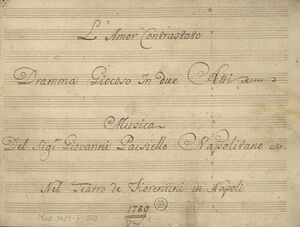Difference between revisions of "Nel cor più non mi sento"
| Line 58: | Line 58: | ||
}} | }} | ||
'''"{{lang|it|Nel cor più non mi sento}}"''' is easily be called the most famous of [[ | '''"{{lang|it|Nel cor più non mi sento}}"''' is easily be called the most famous of [[Giovanni Paisiello|Giovanni Paisiellos]] and [[Giuseppe Palomba|Giuseppe Palombas]] creations.<ref name="Wiki"/> It inspired Ludwig van Beethoven to his ''Six variations in G for piano'', (WoO 70) in 1795. In 1821, Paganini picked up the "Nel cor" for his "Introduction and variations in G major" for violin, (Op. 38, MS 44), which is known to us thanks to concertmaster Carl Guhr who wrote down what he remembered from Paganini's concerts in Frankfurt by ear. | ||
"Nel cor più non mi sento" appears on the following album: | "Nel cor più non mi sento" appears on the following album: | ||
| Line 66: | Line 66: | ||
! width="80px"|Year | ! width="80px"|Year | ||
! Album | ! Album | ||
! | ! With | ||
|- | |- | ||
| | |2021 | ||
| | | [[À sa guitare (Album)]] | ||
| | | [[Thibaut Garcia]] | ||
|} | |} | ||
==Libretto== | ==Libretto== | ||
| Line 85: | Line 84: | ||
| english-title = I no longer feel in my heart | | english-title = I no longer feel in my heart | ||
| composer = [[Giovanni Paisiello]] | | composer = [[Giovanni Paisiello]] | ||
| lyricist = | | lyricist = [[Giuseppe Palomba]] | ||
| work = | | work = [[L'amor contrastato]] | ||
| catalogue = | | catalogue = | ||
| role = | | role = Rachelina | ||
}} | }} | ||
</div> | </div> | ||
Revision as of 22:33, 7 October 2021
| La Molinara ossia l'amor contrastato | |
|---|---|
| Dramma giocoso per musica in due atti by Giovanni Paisiello | |
 First page of the sheet music, Naples, 1789 | |
| Full title | La Molinara ossia l'amor contrastato |
| English | The Fair Maid of the Mill or the Thwarted Love |
| Libretto | Giuseppe Palomba |
| Dedication | A sua altezza reale Maria Amalia, Infanta di Spagna, Arciduchessa d'Austria, Duchessa di Parma, Piacenza, Guastalla ec. ec. ec.[1] |
| Premiere | |
| Date | 1788 |
"Nel cor più non mi sento" is easily be called the most famous of Giovanni Paisiellos and Giuseppe Palombas creations.[2] It inspired Ludwig van Beethoven to his Six variations in G for piano, (WoO 70) in 1795. In 1821, Paganini picked up the "Nel cor" for his "Introduction and variations in G major" for violin, (Op. 38, MS 44), which is known to us thanks to concertmaster Carl Guhr who wrote down what he remembered from Paganini's concerts in Frankfurt by ear.
"Nel cor più non mi sento" appears on the following album:
| Year | Album | With |
|---|---|---|
| 2021 | À sa guitare (Album) | Thibaut Garcia |
Libretto
from L'amor contrastato
Giovanni Paisiello (music), Giuseppe Palomba (words)
Rachelina | |
- ↑ 1.0 1.1 Paisiello, Giovanni (1791). "La molinara ossia l'amor contrastato". MDZ Digitale Sammlungen. Retrieved October 1, 2021.
- ↑ 2.0 2.1 "Nel cor più non mi sento". Wikipedia. Archived from the original on October 8, 2021. Retrieved October 8, 2021.
- ↑ Paisiello, Giovanni (1791). "Parma : Carmignani, 1791. - 4 Bl., 62 S., 1 Bl". OPAC plus.
- ↑ Paisiello, Giovanni. "La molinara, ossia, L'amor contrastato : dramma giocoso per musica in due atti : da rappresentarsi nel R.o teatro alla Scala la primavera dell'anno 1810". Library of Congress. Retrieved October 8, 2021.
- ↑ "L'Amor Contrastato: Dramma Giocoso In Due Atti : Music Del Sigr. Giovanni Paisiello Napolitane; Nel Teatro de Fiorentini in Napoli 1789". IMSLP. Sächsische Landesbibliothek. Retrieved October 8, 2021.
- ↑ Fenner, Theodore (1994). Opera in London: Views of the Press, 1785-1830. SIU Press. p. 75. Retrieved October 8, 2021.
- ↑ Paisiello, Giovanni (1817). "La Molinara; A Comic Opera in Two Acts". Google Books. W. Winchester and Son. Retrieved October 8, 2021.
- ↑ "Gioanni Paisiello, biography". Treccani. Archived from the original on October 8, 2021. Retrieved October 8, 2021.
- ↑ "La Molinara, Paisiello". Opera Manager. Archived from the original on October 8, 2021. Retrieved October 8, 2021.